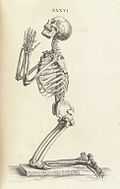Human positions
Human positions refer to the different positions that the human body can take.
There are several synonyms that refer to the human position, often used interchangeably, but having specific flavors.[1]
- Position is a general term for a configuration of the human body
- Posture means the intentionally or habitually assumed position
- Pose implies artistic or aesthetic intention of the position
- Attitude refers to postures assumed for purpose of imitation, intentional or not, as well as in some standard collocations in reference to some distinguished types of posture: "Freud never assumed a fencer's attitude, yet almost all took him for a swordsman."[2]
- Bearing refers to the manner, of the posture, as well as of gestures and other aspects of the conduct taking place
Basic positions
While not moving, a human is usually in one of the following basic positions:
Standing

Although standing isn't dangerous per se, there are pathologies associated with it. One short term condition is orthostatic hypotension, and long term conditions are sore feet, stiff legs and low back pain.
Sitting

Squatting

Lying

- Supine position: lying on the back with the face up.
- Prone position: lying on the chest with the face down ("lying down" or "going prone").
Lying on either side, with the body straight or bent/curled forward or backward. The fetal position is lying or sitting curled, with limbs close to the torso and the head close to the knees.
Kneeling
Crouching

Crouching may involve squatting or kneeling.
All-fours/Cat crawling
This is the static form of crawling which is instinctive form of locomotion for very young children. It is a commonly used childbirth position in non-Western cultures.[5]
Atypical positions

- standing on one leg
- handstand
- head stand
- spreadeagle
- crab position
- Humans can hang in various positions. It is a position where the support is above the center of gravity. It may be voluntary or involuntary.
Such positions are common to break dancing, gymnastics and yoga.
Stress positions

Stress positions place the human body in such a way that a great amount of weight is placed on just one or two muscles. Forcing prisoners to adopt such positions is a method of ill-treatment used for extracting information or as a punishment, possibly amounting to torture. Such positions also are sometimes used as a punishment for children.
Bondage positions
A bondage position is a body position created by physical restraints which restricts locomotion, use of the limbs or general freedom of movement.
Childbirth positions
In addition to the lithotomy position still commonly used by many obstetricians, childbirth positions that are successfully used by midwives and traditional birth-attendants the world over include squatting, standing, kneeling and on all-fours, often in a sequence.[6]
Dance positions
Dance position is a position of a dancer or a mutual position of a dance couple assumed during a dance. Describing and mastering proper dance positions is an important part of dance technique.
Defecation positions
The two most common defecation positions are squatting and sitting. The squatting posture is used for Japanese toilets and squat toilets. It is also commonly used for defecation in the absence of toilets or other devices. The sitting defecation posture is used in Western toilets, with a lean-forward posture or a 90-degrees posture. In general, the posture chosen is a cultural decision although the case has been made that squatting provides health benefits over sitting.
Eating positions
Heat escape lessening position
The heat escape lessening position (HELP) is a way to position oneself to reduce heat loss in cold water. It is taught as part of the curriculum in Australia, North America and Ireland for lifeguard and boating safety training. It involves essentially positioning one's knees together and hugging them close to the chest using one's arms.
Medical positions
The following positions are specifically used in medicine:[7]
- anatomical position
- Bozeman's position
- decubitus position
- Fowler's position
- knee-chest position
- knee-elbow position
- lithotomy position
- Mayer position
- Rose's position
- semi-Fowler position
- Sims position
- Trendelenburg position
- verticosubmental position
- Waters' position
Recovery position
The recovery position or coma position refers to one of a series of variations on a lateral recumbent or three-quarters prone position of the body, into which an unconscious but breathing casualty can be placed as part of first aid treatment.
Resting positions
A large number of resting positions are possible, based on variations of sitting, squatting, kneeling or lying.[8]
Sex positions
Sex positions are positions which people may adopt during or for the purpose of sexual intercourse or other sexual activities. Sexual acts are generally described by the positions the participants adopt in order to perform those acts.
Shooting positions
Sleeping positions
The sleeping position is the body configuration assumed by a person during or prior to sleeping. Six basic sleeping positions have been identified:
- Fetus (41%) – curling up in a fetal position. This was the most common position, and is especially popular with women.
- Log (15%) – lying on one's side with the arms down the side.
- Yearner (13%) – sleeping on one's side with the arms in front.
- Soldier (8%) – on one's back with the arms pinned to the sides.
- Freefall (7%) – on one's front with the arms around the pillow and the head tilted to one side.
- Starfish (5%) – on one's back with the arms around
Submissive positions
- Genuflection (or genuflexion) is bending at least one knee to the ground, was from early times a gesture of deep respect for a superior.
- Kneeling is associated with reverence, submission and obeisance, particularly if one kneels before a person who is standing or sitting.
- Kowtowing is the act of deep respect shown by kneeling and bowing so low as to have one's head touching the ground.
- Prostration is the placement of the body in a reverentially or submissively prone position.
Asanas
Certain asanas were originally intended primarily to restore and maintain a practitioner's well-being, improve the body's flexibility and vitality, and promote the ability to remain in seated meditation for extended periods.
See also
- Abnormal posturing
- Anatomical terms of location
- Alexander Technique
- Contortionism
- Ergonomics
- Feldenkrais Method
- Gait (human)
- Human anatomical terms
- Mitzvah Technique
- Neutral spine
- Positional asphyxia
- Postural Integration
- Posture release imagery
- Terrestrial locomotion in animals
References
- ↑ "Position." Dictionary.com, Unabridged (v 1.1). Random House, Inc. 24 October 2007. Reference.com
- ↑ Fritz Wittels, "Freud and the Child Woman: The Memoirs of Fritz Wittels", SBN 0300064853, Google Books, p.49
- ↑ Abstract Kinematic and kinetic validity of the inverted pendulum model in quiet standing, NIH
- ↑ http://en.wiktionary.org/wiki/crouch
- ↑ Engelmann GJ Labor Among Primitive Peoples (1883)
- ↑ Engelmann GJ Labor Among Primitive Peoples (1883)
- ↑ http://medical-dictionary.thefreedictionary.com/knee-chest+position
- ↑ Hewes GW: ' World distribution of certain postural habits' American Anthropologist, 57, (1955), 231-44
Further reading
- Hewes GW: The anthropology of posture Scientific American, 196: 122-132 (1957)
| Wikimedia Commons has media related to Standing. |
| Wikimedia Commons has media related to Kneeling. |
| Wikimedia Commons has media related to Sitting. |
